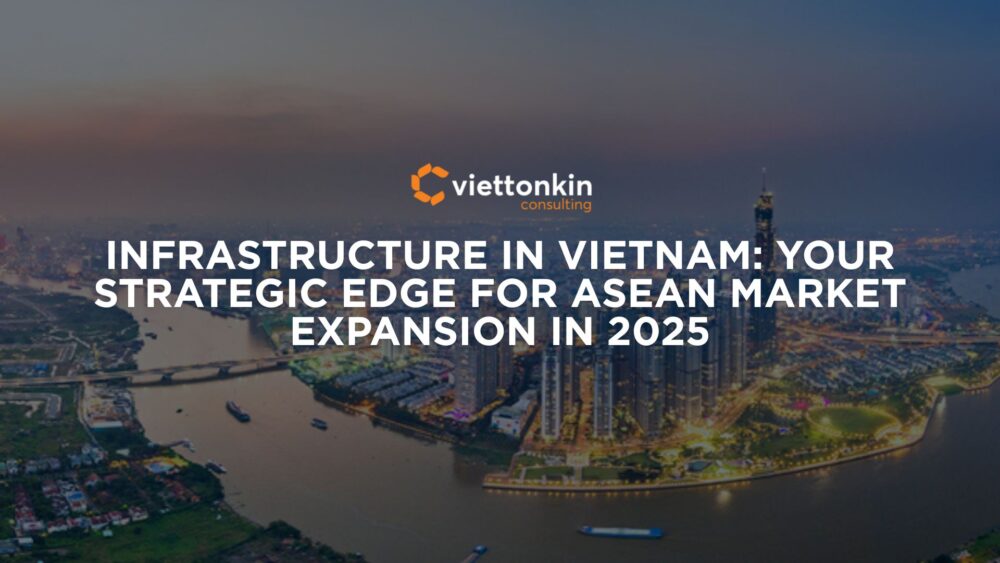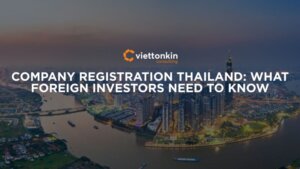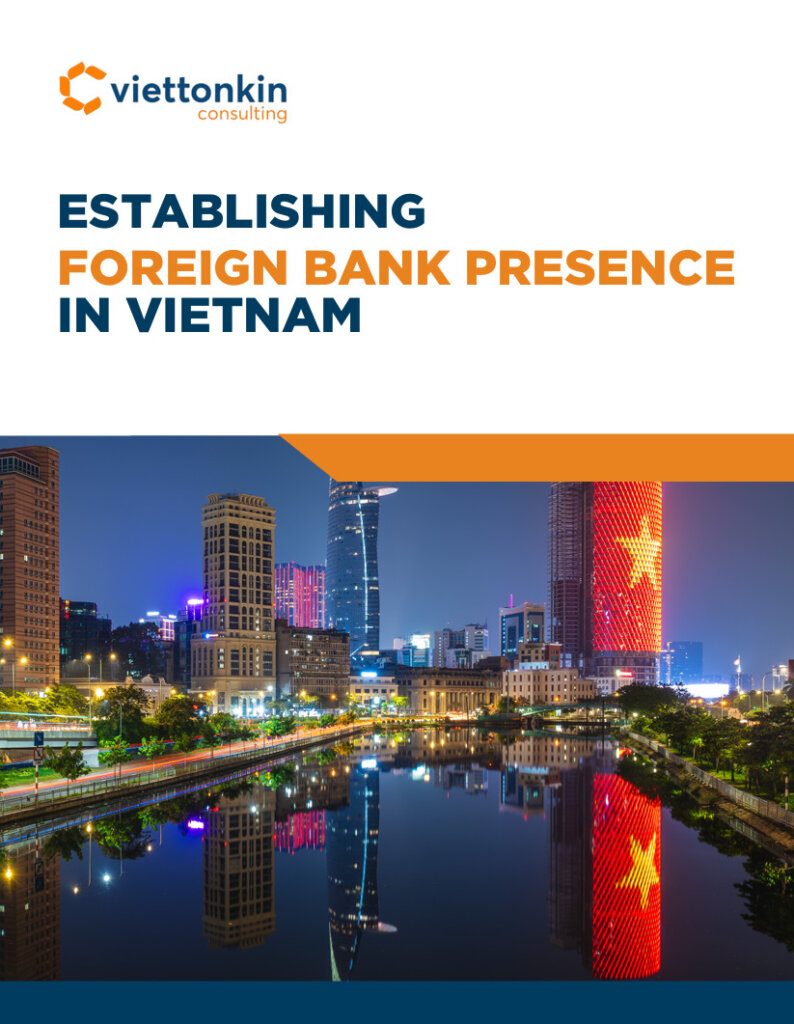Vietnam's food trade industry is one of the most dynamic sectors in the country. Fueled by an expanding middle class, rising disposable incomes, and shifting consumer preferences, the increasing demand for high-quality food products is undeniable. From bustling markets in Ho Chi Minh City to modern supermarkets in other major cities, the opportunity for both […]
Ever wondered how to unlock true expansion across Southeast Asia? Here’s the reality: without world‑class infrastructure - roads, ports, power, and digital networks - your growth plan stalls. Vietnam’s infrastructure build‑out is outpacing many peers—massive Capital Expenditure under the National Master Plan 2030 is driving new highways, ports, power grids, and 5G rollout, though last‑mile logistics and rural utilities still lag.
Vietnam’s infrastructure is now the focus of ongoing development and modernization, with major projects on transport, utilities and sustainable growth. As a consultant who has spent over two decades on the ground helping businesses scale in Vietnam, China and Malaysia, I’ve seen that logistics, power and digital readiness are the foundation of any successful FDI venture.
The government is determined to develop infrastructure and embrace Industry 4.0 is a key driver of Vietnam’s modernization and economic growth. Infrastructure upgrades are necessary for modernization, for current needs and future ambitions. Vietnam’s growing population and rapid urbanization is putting pressure on existing infrastructure, so upgrades and expansion are necessary to meet demand.
These are crucial to ensure economic growth and competitiveness in the region. Right now, Vietnam’s infrastructure evolution is reshaping the entire region’s business landscape, with a clear focus on making Vietnam a regional logistics hub through upgrades and expansion—a game-changer for investors with vision.
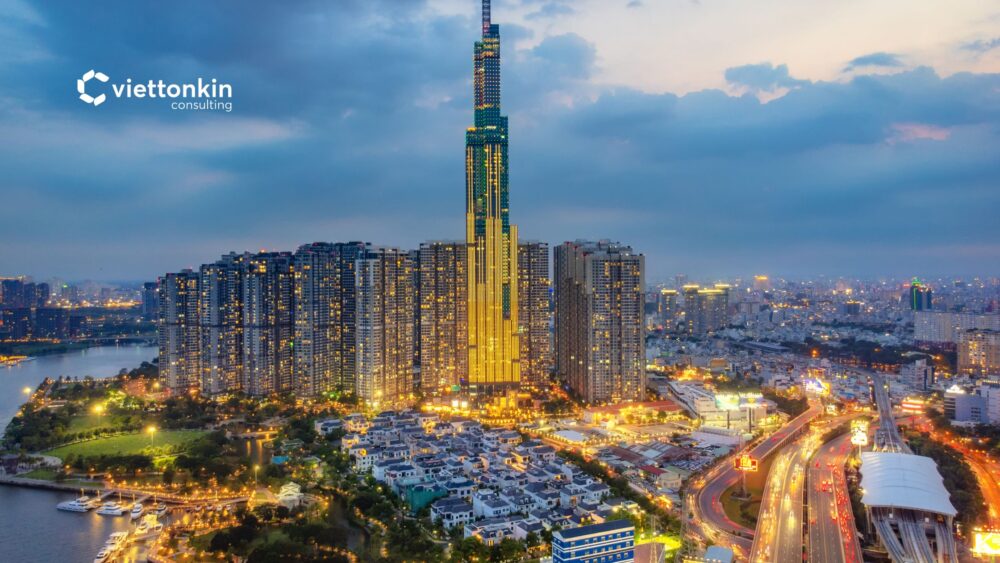
Takeaways:
- National Master Plan 2030: Under Decision 237/QĐ‑TTg (2024), Vietnam commits 5% of GDP to modernize highways, railways, power grids (including PDP8), and national 5G coverage—making infrastructure a top‑tier priority.
- PPP Models Unlocked: The PPP Law 2020 and Decree 35/2024/NĐ‑CP detail BOT/BLT/BOO structures, state guarantees, and viability gap funding—inviting global investors into transport and energy projects with clear legal safeguards.
- PDP8’s Green Pivot: Per Decision 1254/QĐ‑TTg (2023), LNG‑to‑power and offshore wind are priority sectors—with feed‑in tariffs and grid‑access rules set to attract ~$30 billion in private capital through 2030.
- Transport Upgrades: The North–South Expressway (1,800 km under Decision 436/QĐ‑TTg), Cai Mep–Thi Vai and Lach Huyen deep‑water ports expansion, plus Cat Lai port upgrades, slash logistics costs by 20% for ASEAN–EU trade lanes.
- Gaps are Opportunities: Shortages in temperature‑controlled warehousing, water/waste utilities in IPs, and urban last‑mile networks represent white spaces—backed by Decree 59/2023/NĐ‑CP incentives for green and smart‑park infrastructure.
Introduction to Vietnam: ASEAN’s Rising Star
Vietnam leads Southeast Asia’s economic transformation—its land borders with China, direct access to the South China Sea, and deep‑water port network make it a natural ASEAN gateway. Sustained FDI inflows (over $22 billion in 2024) under the Investment Law 2020 (amended 2025) underscore its rising appeal. Since 2015, Vietnam has channeled over 4% of annual budget to infrastructure—roads, rail, ports, and digital networks—per Budget Law 2024. These investments cut average freight time by 30%, accelerated urbanization in HCMC & Hanoi, and boosted exports to $380 billion in 2024.
Major cities like Ho Chi Minh City have become hubs of commerce, logistics and innovation, driving the country’s economic growth. The government’s vision is clear: to make Vietnam a global infrastructure hub, supporting high-value manufacturing, efficient trade and sustainable development. This is reflected in the country’s efforts to reduce logistics costs, enhance connectivity and attract big investments from domestic and foreign investors.
Vietnam’s transport infrastructure is being modernized comprehensively, with strategic initiatives and upgrades to support economic growth and regional connectivity. As Vietnam upgrades its infrastructure, it’s setting the stage for long-term growth and solidifying its position as a leading economic power in Southeast Asia.
Vietnam’s Infrastructure Landscape: Past, Present and Future
Vietnam’s infrastructure journey is a story of transformation and ambition. Decades ago, the country’s transport infrastructure—national highways, railways and inland waterways—was a legacy of the French colonial period, underdeveloped and unable to meet the demands of a growing economy. But over the last two decades, the Vietnamese government has invested heavily in infrastructure development to drive economic growth and regional integration.
Now Vietnam’s infrastructure is modernizing fast. Major cities like Ho Chi Minh City and Hanoi are connected by upgraded national highways and expressways, large scale infrastructure projects like the North-South Expressway and port expansions have reduced logistics costs and improved the transport industry. Inland waterways and existing connectivity networks have been developed and strengthened to move goods and people across the country. Long Thanh International Airport is being built to make Vietnam a global infrastructure hub to meet the demand for passenger and cargo transport.
Private sector participation is a key part of Vietnam’s infrastructure development strategy. Through public-private partnerships, the government is mobilizing private investment to deliver critical infrastructure projects, from industrial zones to renewable energy sector initiatives. Artificial intelligence and digital technologies are being integrated into project management and utility infrastructure to create smarter and more sustainable cities.
Looking forward, Vietnam’s infrastructure landscape will evolve even more. The government’s targets are to expand national highways, develop high-speed railways and modernize major ports to support international trade. Renewable energy will play a key role with new projects to diversify the national energy mix and support sustainable development. As industrial zones and deep water ports expand and technology is embedded in infrastructure projects, Vietnam will be able to meet the demands of urbanization and ensure long-term growth.
Vietnam’s National Infrastructure Plan and What It Means for Investors
2030 and 2050: Transport, Power and Digital Targets
Vietnam is not just thinking about tomorrow; it’s planning for the next generation. The government’s national master plan is a clear roadmap for synchronized development, reflecting the rapid advancement of Vietnam’s infrastructure and the importance of ongoing investment to support economic growth and modernization.
According to a 2024 report from The Diplomat, Vietnam’s legislature is set to approve a slate of key infrastructure projects to achieve its economic growth targets. The project pipeline is impressive, featuring a range of investment projects in the national plan, including the full-length North-South Expressway, a future high-speed rail line to upgrade the broader railway network and support modernization, and several LNG-to-power plants.
The plan also includes new international airports to enhance global connectivity and support economic growth, and upgrades to major airports to handle passenger and cargo traffic and reduce congestion. This isn’t just about building roads; it’s about creating economic corridors to connect industrial zones to global markets.
Public-Private Partnership Models and State Guarantees
Vietnam can’t build this future alone. The government has created a clear path for foreign capital through its Public-Private Partnership (PPP) law.As detailed by Dazpro in its analysis of Decree 35, the framework allows for various models like Build-Operate-Transfer (BOT) and offers mechanisms like government guarantees and viability gap funding to de-risk projects for private investors. For you, the investor, this means the door is open to participate in nationally significant projects with a structured legal and financial framework.
Which Provinces Will See Infrastructure Development-Led Growth?
Strategic insight means knowing where the growth will be fastest.
- Southern Logistics Belt: Provinces like Binh Duong, Dong Nai and Long An, which form the industrial heartland around Ho Chi Minh City, will benefit most from port and road upgrades. Road transport plays a key role in connecting these industrial zones, ensuring smooth movement of goods and people. With major ports in this region, logistics and trade will be further boosted, driving economic growth. Joint venture port companies will expand port capacity and attract foreign direct investment, while major shipping lines will enhance regional trade and strengthen Vietnam’s integration with global supply chains.
- Northern Corridors: Hanoi to Haiphong to Quang Ninh is a manufacturing powerhouse, especially for electronics.
- Central High-Potential Zones: Watch Da Nang and its neighbors. They are developing fast as tech, tourism and high-value manufacturing hubs, backed by new infrastructure links.
On-the-Ground Progress: Major Projects by Sector
Transport Infrastructure: Ports, Roads and High-Speed Rail
Vietnam is moving, driven by the modernization of Vietnam’s transport infrastructure and transportation infrastructure. The Cai Mep-Thi Vai deep-water port complex can now accommodate the world’s largest container ships, making it a real alternative to regional transshipment hubs. Inland waterways, with Vietnam’s extensive network of rivers and canals, are also being developed as a key part of freight and passenger transport, supporting the country’s logistics strategy.
The North-South Expressway is being built in sections, already reducing travel time between industrial zones. These highway projects are a key part of Vietnam’s efforts to modernize its road network, boost regional connectivity and support trade integration. The national high-speed rail is a longer-term vision, but urban metro lines in Hanoi and Ho Chi Minh City are slowly becoming a reality to ease urban congestion.
Hanoi’s first metro line, the Cat Linh-Ha Dong line, has been operational since 2021, a major milestone in the city’s urban transit development. Both Hanoi and Ho Chi Minh City have plans for 8 metro lines each to modernize public transportation and reduce traffic congestion in major cities. Besides metro development, Tan Son Nhat, the main international airport in Ho Chi Minh City, continues to play a vital role in Vietnam’s aviation growth and national transportation network.
However, delays and slow progress in some metro projects have been attributed to management board inefficiency, highlighting the need for better project management and investment.
Energy Infrastructure: LNG, Renewables and Grid Expansion
Energy is changing. As reported by the Associated Press, Vietnam’s Power Development Plan 8 (PDP8) is a big shift away from coal towards cleaner energy sources. The plan calls for massive investment in domestic gas and LNG import terminals, and a big push into offshore wind and solar power. Renewable energy is becoming more important in Vietnam’s infrastructure strategy, supporting the country’s energy transition and sustainable development goals. While grid stability is a challenge, it’s also an investment opportunity in grid modernization and energy storage solutions.
Digital Infrastructure: 5G, Data Centers and Smart Parks
The foundation of a modern economy is digital. Vietnam’s National Digital Transformation Strategy is driving investment in 5G networks, fiber optic cables and world-class data centers. This digital backbone is enabling the rise of “smart parks” – industrial zones with integrated digital services that offer manufacturers a competitive edge in efficiency and data management.
Where the Infrastructure Gaps Create Investment Opportunity
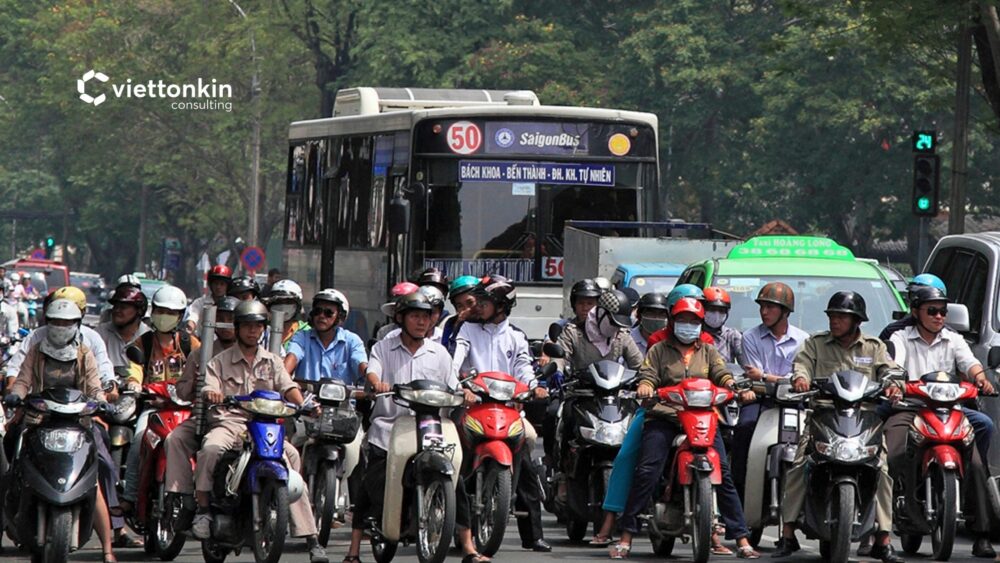
A true strategist sees opportunity where others see problems. Vietnam’s infrastructure gaps are your invitation to invest in high-demand solutions.
- Urban Congestion and Cold Chain Shortfalls: HCMC and Hanoi are growing fast and their logistics networks are strained. There is a critical shortage of modern cold storage facilities, a major bottleneck for food processing and pharmaceutical industries. Investing in cold chain logistics is a game-changer. Improvements in utilities access, such as electricity and water, have been notable over the same period (2017-2020), though disparities remain between urban and rural areas.
- Industrial Park Utilities and ESG Integration: Many existing industrial parks need infrastructure upgrades in water treatment, waste management and reliable power. This creates a huge opportunity for companies specializing in green infrastructure and sustainable utilities to meet the rising ESG demands from multinational tenants.Investment in utility infrastructure is essential to support the utilities sector which plays a key role in Vietnam’s economic growth. State owned enterprises, such as Vietnam Electricity Company (EVN), are heavily involved in providing essential utilities and managing operational responsibilities within this sector.
- Talent and Human Infrastructure: Don’t forget the human element. There is a need for better “soft infrastructure” – vocational training centers, digital onboarding platforms and scalable HR solutions – to ensure a ready and skilled workforce can power these new factories and logistics hubs.
Business and Investment Climate: FDI, Regulatory Landscape and Market Entry
Vietnam’s business and investment climate has made it the top destination for foreign direct investment in Southeast Asia. The government’s commitment to infrastructure development and economic modernization is matched by a regulatory environment that encourages private sector investment and foreign participation. Major cities like Ho Chi Minh City and Hanoi are the economic engines, offering plenty of opportunities for investors in sectors from manufacturing and logistics to technology and tourism.
The regulatory landscape in Vietnam is designed to facilitate market entry, with streamlined procedures for setting up businesses and a range of incentives for foreign investors. Special economic zones and industrial parks provide attractive locations for investment, supported by robust infrastructure and access to major ports. While the process is generally smooth, foreign investors should be prepared to navigate some bureaucratic complexities and comply with local regulations.
Market entry options are flexible, allowing foreign investors to set up wholly foreign-owned enterprises or to form joint ventures with local partners. Public-private partnerships have become a key mechanism for private sector participation in infrastructure development, enabling investors to participate in large-scale projects with government support. The development of major ports, including the deep water port at Cai Mep, has significantly improved Vietnam’s logistics capabilities, reducing trade barriers and supporting the efficient movement of goods to and from global markets.
Private sector investment now accounts for a significant portion of Vietnam’s economic growth, reflecting the government’s strategy to tap into the expertise and capital of private and foreign investors. The ongoing expansion of infrastructure, especially in major cities and logistics corridors, creates new opportunities for growth. With a favorable investment climate, a proactive government and a rapidly developing infrastructure network, Vietnam is the prime location for businesses looking to expand in Southeast Asia.
Infrastructure-Driven ESG and Impact Investment in Vietnam
ESG Mandates in Infrastructure Finance
Sustainability is no longer a buzzword; it’s a requirement. Major development finance institutions like IFC and ADB are embedding strict ESG frameworks into their funding for Vietnamese infrastructure projects. PDP8 itself has sustainability targets. For investors, this means demonstrating strong ESG credentials is not just good practice; it’s essential for financing and social license.
Resilient Infrastructure for Climate Adaptation
With its long coastline, Vietnam is on the front lines of climate change. This creates an urgent need and a massive investment opportunity for climate-resilient infrastructure. Projects focused on smart drainage systems to combat urban flooding, coastal protection and energy-efficient building design are in high demand.
Impact Measurement and ROI for Long-Term Infrastructure Projects
Investing in infrastructure is a long-term play. Success requires sophisticated financial modeling that accounts for not just the direct IRR but also the powerful multiplier effects: job creation, regional economic development and the attraction of further FDI. This is how you build a case for impact and return.
How to Navigate Vietnam’s Public-Private Project Landscape
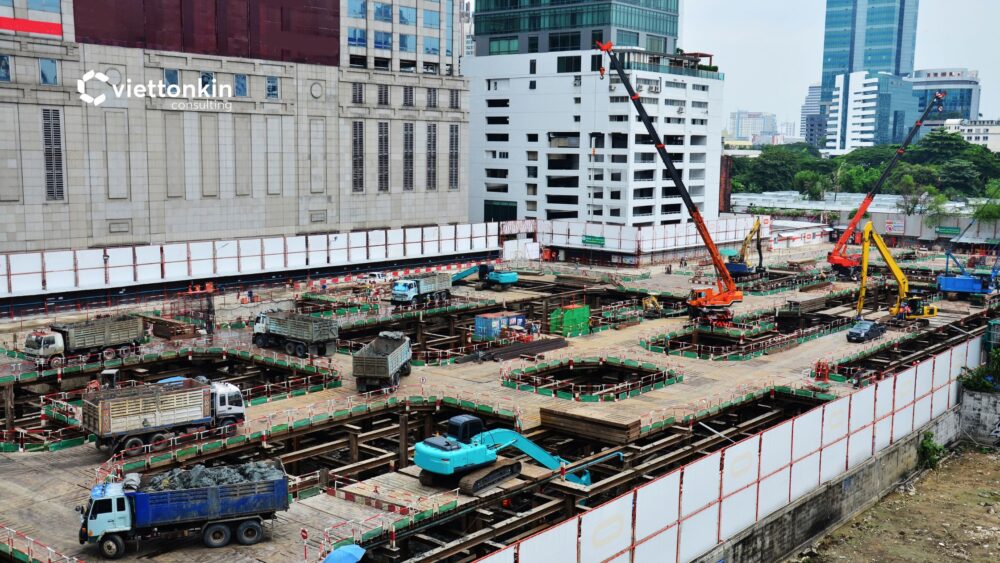
Pre-Investment Feasibility and Regulatory Requirements
Entering an infrastructure project requires a risk-proof strategy. The pre-investment phase is critical and involves land clearance approvals, comprehensive Environmental Impact Assessments (EIAs) and securing the right licenses. You’ll need to choose the right PPP structure like BOT or Build-Operate-Own (BOO) that aligns with your financial model and risk tolerance.
[Infographic: Public-Private Investment Lifecycle in Vietnam (PPP Model)]
Financing Structures and Local Capital Markets
Financing these large-scale projects often involves a blend of international and local capital. Understanding how to work with Vietnamese banks, development finance institutions and potentially the local bond market is key. A solid strategy for currency hedging and ensuring clear pathways for cash repatriation is non-negotiable.
Case Studies: What Success Looks Like
We’ve seen success firsthand. The PPP model was used to develop world-class container terminals at Cai Mep-Thi Vai. Major international investors are now pouring billions into LNG-to-power projects in provinces like Bac Lieu. The ongoing development and expansion of Noi Bai International Airport further demonstrates Vietnam’s commitment to modernizing its airport facilities to meet growing passenger and cargo demands.
Leading industrial developers are rolling out networks of smart parks in Binh Duong, setting a new standard for manufacturing excellence. Vietnam is following the infrastructure-driven growth model seen in high-income nations like South Korea, which has successfully developed its transportation infrastructure through similar strategies.
Conclusion and Future Outlook: Build More Than Roads—Build ASEAN Access Through Vietnam
Vietnam’s infrastructure story is far from over—it’s entering a new era of innovation, integration and opportunity. The government’s commitment to infrastructure investment and sustainable development will continue to drive growth and competitiveness. As public-private partnerships mature and private sector participation deepens, Vietnam will deliver even more ambitious infrastructure projects connecting major cities, industrial zones and global markets.
Looking ahead, the expansion of transport infrastructure, smart utility systems and integration of technologies like AI will further reduce logistics costs and support higher growth. For investors and businesses, Vietnam’s infrastructure is not just about accessing one market—it’s about building a bridge to the entire ASEAN region and beyond. By investing in Vietnam’s infrastructure, you’re not just building roads or ports—you’re building the foundation for long-term success in Southeast Asia’s fastest growing economy.
Conclusion: Build More Than Roads—Build ASEAN Access Through Vietnam
Infrastructure is Vietnam’s most powerful competitive advantage in the race for FDI in Southeast Asia. The government’s commitment is clear, the framework is in place and the opportunities are huge. For global companies looking to de-risk their supply chains and tap into the region’s growth, investing in or leveraging Vietnam’s new infrastructure is the ultimate competitive edge. This is how you build your gateway to the entire ASEAN market.
Work with us to turn challenges into wins. We provide the investor intelligence and on-the-ground navigation to make your infrastructure-led investment succeed. Because when it comes to your next big break, there’s only one way forward.
You might also like: What Is Green Investment and Why It Matters in 2025




